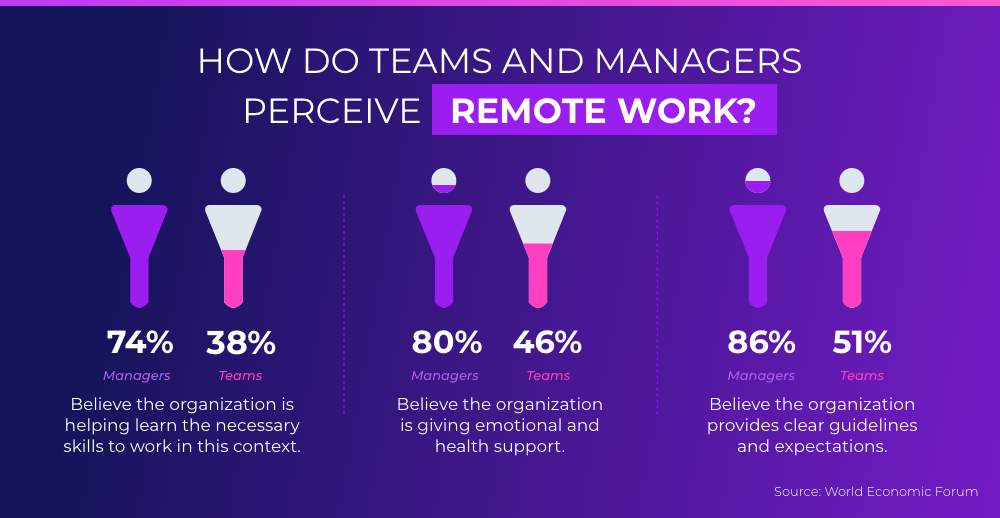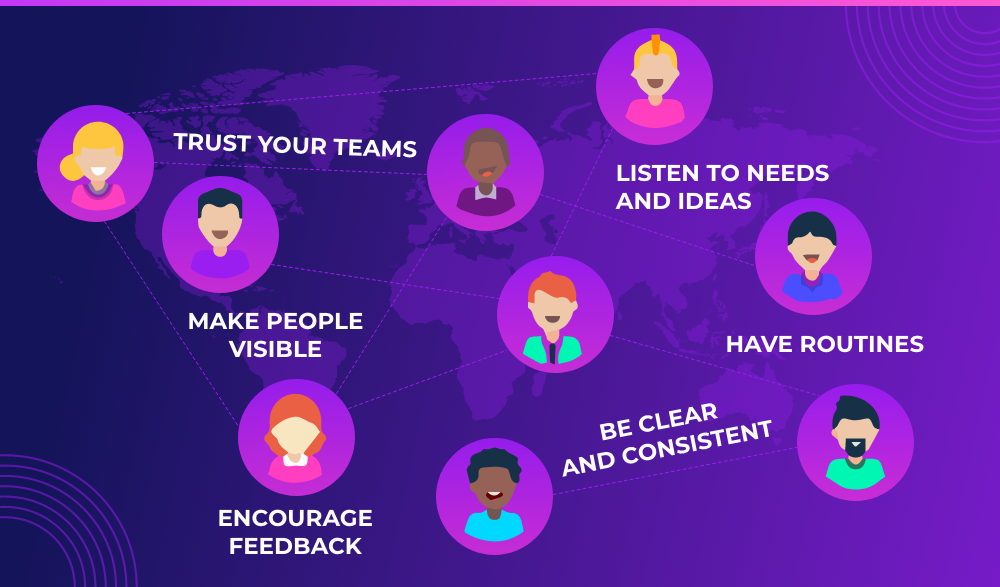How to manage remote teams? Thumbs up if you know the answer!
Written by María Eugenia Raffaele
Is remote work here to stay? Most certainly yes. In this new normal that has sparked a drastic exodus of workers from office, the question on how to manage remote teams has turned out rather challenging, mainly because what seemed like a short-term inconvenience, has become a permanent shift in not only where, but how people work.
Roughly 40% of employees in developed economies have worked remotely for the past year and numbers continue growing today. With a mix of in-office and remote employees, teamwork from home can be hard for both managers and workers, especially if they don’t see needs and reality eye to eye. Although managers feel they are doing their best to keep teams engaged, cohesive and productive, employees don’t seem to perceive reality that way. Actually, they claim that their remote experience lacks the proper training and support they need. Check this out:

Good news is if you’re reading this, it means you care for your teams and you’re looking for effective practices to ensure they have the best possible experience. Truth is permanent remote work is expected to double to 34.4% and around 72% of worldwide employees are currently working remotely. So without further ado, we’d like to share with you the top strategies on how to manage remote teams and sustain a cohesive company culture where people complement their skills, stay productive, and feel engaged.
Approachable strategies
Managing a team certainly is a complex task, and even more so when people are not all in the same place. You probably wonder “How do I build, sustain and create a culture with remote teams?” “How do I keep them engaged, connected and motivated?” “How much should I be there for them without micromanaging or interrupting their work all the time?”
Truth is there are many strategies and tips to manage remote teams out there, but you have to find the ones that fit your teams’ and company’s needs and goals.
The way towards an effective remote team building consists of 3 key steps:

Strategy 1: What do my teams need? Connect with them and listen carefully
This is the main keystone to succeed in your future choices and decisions as a manager. Apart from getting valuable insight on how people are doing and what their needs are, you’ll be creating more visibility, building trust, and empowering your teams.
Teams working remotely are mostly concerned about whether they are all on the same page, going the right direction or not. So, you are the one who has to be there for them all the time – you won’t be micromanaging, you’re simply showing you care and are open to listen to their needs to make their work dynamics more efficient and fulfilling.
PRACTICAL TIPS:
- Send out frequent pulse surveys asking about needs, ideas and doubts
- Carry out one-on-one meetings to make sure you see reality eye to eye
- Give and, most importantly here, ask for feedback to make sure you’re keeping track of emerging needs
Strategy 2: Be honest and review your practices
Sometimes you think you’re doing things great, but you might be wrong… When you go over people’s surveys and feedback, make sure you keep a reflexive open mind. Even negative feedback is always positive as long as you see it in a new light and use it as a tool for self-improvement.
This moment is an opportunity to review the way you’re doing things and take smarter and more accurate decisions that truly respond to people’s needs. Sometimes your teams need to be heard, feel more visible, or might not fully understand how to do certain tasks and need further training. Once you know their needs, make sure you plan effective ways to approach each.
PRACTICAL TIPS:
- Have regular scheduled check-ins once a week: Especially people working remotely need to feel their leaders are reachable and give them a sense of direction. Make sure you set and align goals and objectives together – make them part.
- Make them visible: Acknowledge their hard work by giving them recognition and reassurement that they are on the right path. Everyone should visualize everyone’s work too. This way teams making a greater impact can positively influence others’ performance.
- Enhance connections among other teams and leaders across the company: This is a positive way to embrace community, which in times of remote work, can be a valuable strategy to connect and feel engaged.
- You can never be too clear: Don’t assume others understand your brevity. Take extra time to be extra clear. Physical distance can be our worst enemy without effective communication. Clarity and consistency are the key so, set clear goals, due dates and use effective communication platforms like Slack or Microsoft Teams, which are free to use and make communication between coworkers easier.
Strategy 3: Growth mindset and adaptation
This is our last, but not least strategy to consider when it comes to managing remote teams. Growth mindset organizations can effectively find ways to recreate the emotional and professional connections that existed among their teams before the pandemic and see remote work as an opportunity to enhance innovation.
And, once again, here lies the key to success: your organizational culture. You need to create a culture that transcends location and be clear about what your culture is about, what your mission and values are, how you do things in the company and why you are in business doing what you do. If you get to transmit all members of your team, no matter where they physically are, it’ll be easier for them to feel they belong to the company and connect with its culture and goals.
PRACTICAL TIP:
In you next manager meeting, we suggest you put these growth-mindset questions on the table:
- What do we want the experience of our remote teams to feel like?
- How can we use technology to provide more creative and innovative responses to people’s needs?
- How are we making team members connect and come together?
- Are we making remote workers – I mean all of them, even new employees – part of our organizational culture?
- Are we digital enough?

What happens to companies that don’t reflect upon these questions?
The answer is simple: they won’t be able to manage remote teams successfully. You need to transmit intentionality, concern or thoughtfulness. Encourage meetings with your colleague managers to think of creative and innovative ways to keep your employees engaged and motivated, and sustain your organizational culture beyond any possible boundaries. Otherwise, you are bound to fail as an organization sooner or later.
At Globant, although we are used to sporadic teleworking, we also had to review our ways of doing things in order to ensure good team cohesion and keep people motivated, connected and engaged even working remotely. We simply kept an open innovative mind, heard all voices, and applied the necessary technology to offer our teams the resources they needed to feel supported.
So, how to manage remote teams? As we stated before, all companies have different cultures and different needs, but if we made it happen, so can you. Therefore, we encourage you to continue questioning yourself, and keeping an open mind to make the most of your culture and engage your remote employees everyday. The future of work is here, and we can help you create your way forward.